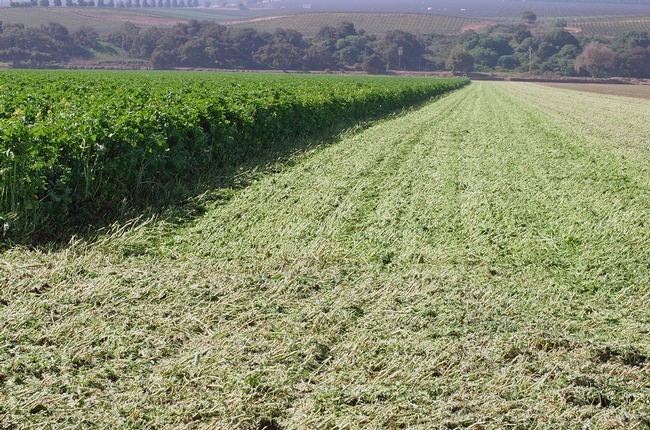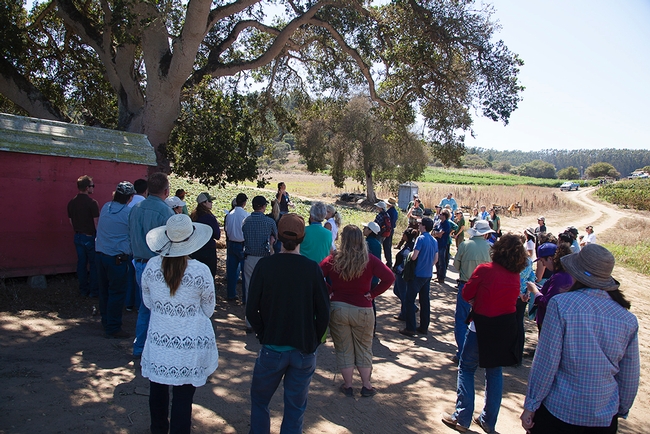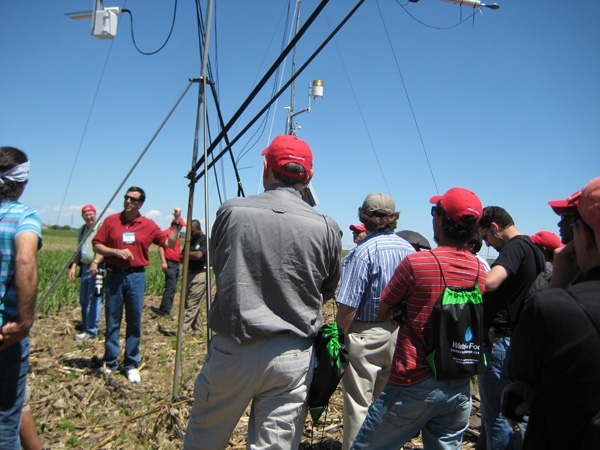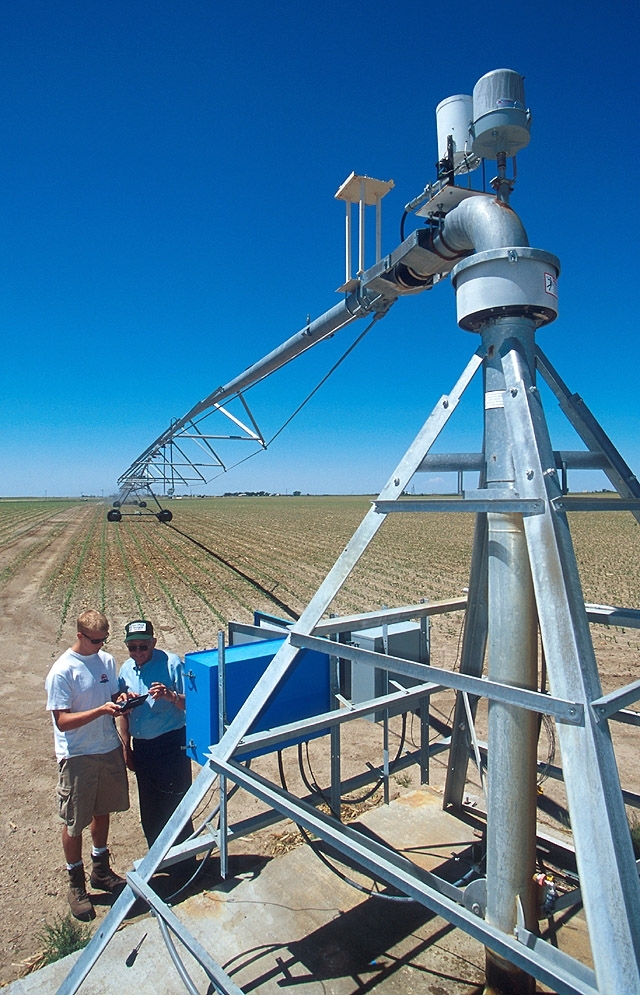Posts Tagged: conservation
UCCE offers online training for protecting food safety and natural resources
On their farms, growers are active stewards of the land, protecting soil quality and water quality as well as supporting wildlife by preserving their habitat. At the same time, fresh produce growers must ensure that their crops are free from pathogens that can cause foodborne illnesses.
To help growers and food safety professionals achieve all of these important goals, UC Cooperative Extension has launched a free online course.
“Actions that farmers take to protect food safety may affect natural resources, and conservation practices may affect food safety,” said Mary Bianchi, UC Cooperative Extension advisor in San Luis Obispo and Santa Barbara counties, who oversaw design of the course.
The intent of the training is to demonstrate that communication between food safety professionals and growers can help to achieve a balance between food safety and sustainability.
“Our co-management course will help food safety professionals better evaluate the risk of conservation practices,” said Bianchi.
“For example, cover crops attract beneficial insects, help control soil erosion and improve soil quality, but they may attract wildlife,” she said. “In the course, we demonstrate frank conversations between food safety auditors and growers about strategies for minimizing the potential risks of crops being contaminated by animal feces. Growers can often provide existing examples, such as monitoring programs or temporary fencing that excludes wild and domestic animals from produce fields.”
The course also provides growers with tools to evaluate their strategies for managing food safety and sustainability.
“After the training, growers and auditors will be better prepared to engage in realistic and frank discussions of co-management strategies used in crop production,” Bianchi said.
The free online co-management course and related resources are online at http://cesanluisobispo.ucanr.edu/Co-management_of_Food_Safety_and_Sustainability.
This project was funded by a $39,650 grant from the University of California Agriculture and Natural Resources.
A video describing co-management practices from farm to fork can be viewed at https://www.youtube.com/watch?v=_IoQ-8OEuc4&feature=youtu.be.
The University of California Global Food Initiative aims to put the world on a path to sustainably and nutritiously feed itself. By building on existing efforts and creating new collaborations among UC's 10 campuses, affiliated national laboratories and the Division of Agriculture and Natural Resources, the initiative will develop and export solutions for food security, health and sustainability throughout California, the United States and the world.
Growers, conservationists, food safety professionals discuss food safety, water quality
Growers, conservationists, food safety professionals discuss food safety, water quality
To help farmers and growers efficiently achieve the best results, the University of California Cooperative Extension, in collaboration with the Farm Food Safety and Conservation Network brought together 80 people on Aug. 21 for the sixth annual Food Safety and Water Quality Co-management Forum in Watsonville.
"The Farm, Food Safety & Conservation Network is leading the way in co-management of California's agricultural resources,” said Craig McNamara, president of the California Board of Food and Agriculture. “Their recent forum on food safety and water quality brought together the best and the brightest from the Central Coast region to discuss these important issues."
McNamara, who was the keynote speaker, provided his perspective on broadening the view of food safety to include managing agriculture within the context of sustainable agriculture, ecosystem conservation and food insecurity. He also related the discussion of co-management to California’s Ag Vision 2030, a stakeholder-driven process of setting priorities for the future of California agriculture.
Forum participants heard the latest information on designing on-farm practices that might create co-management solutions for nutrients, pesticides and pathogens in the production environment. They also engaged in frank discussion of co-management challenges and solutions at all levels of the supply chain, from large company policies to field-level practices of individual growers.
“Research results show us that we do know quite a bit’ explained Mary Bianchi, UC Cooperative Extension advisor in San Luis Obispo and Santa Barbara counties. “The question now is how do we put that knowledge into action? How can we move towards design and management of on-the-ground management practices and policy programs that reflect our evolving understanding?”
The forum concentrated on the types of practices and policy programs that may help, and discussed strategies, both field-based and policy-driven, that might support progress in addressing persistent resource concerns relevant to agricultural production.
“The forum presents a great opportunity for anyone interested in learning about the key co-management issues on the Central Coast and is a great way to network with experts in the field,” said Afreen Malik, Ocean Mist Farms manager of Food Safety and Environmental Stewardship.
Scientists led a discussion on the fate and transport of nutrients, pesticides, and pathogens and how science can be applied to design practices for co-management decisions in the field. The scientific panel included Tim Hartz, UC Cooperative Extension specialist in the Department of Plant Sciences at UC Davis; Rob Atwill, UCCE specialist in the School of Veterinary Medicine and director of the Western Institute for Food Safety and Security; and Brian Anderson, UC Davis specialist based at the Marine Pollution Studies Laboratory at Granite Canyon.
A panel of industry leaders discussed how policy changes and decision-support tools could support sound co-management. The panel included Ken Harris, executive officer of the Central Coast Regional Water Quality Control Board; Asif Maan, branch chief of CDFA Feed, Fertilizer, and Livestock Drugs Regulatory Services; Kris Gavin of Growers Express; Scott Horsfall, CEO of Leafy Greens Handlers Marketing Agreement; and Lisa Lurie of Santa Cruz Resource Conservation District.
Following the panel discussions, participants visited an organic vegetable and berry farm near Watsonville. The landowner, growers and food safety professionals discussed how they manage for both food safety and environmental quality, which some people see as conflicting priorities.
“I don’t see any conflicts between properly implemented co-management practices and protection of water quality,” said Ken Harris, executive officer of the Central Coast Regional Water Quality Control Board after completing a field exercise at the ALBA Triple M Ranch outside Watsonville.
Brendan Miele, director of California farming operations for Jacobs Farm/del Cabo Inc., added, “I would say the same thing, but would change that to food safety.”
Participants were surveyed before and after the forum. “After the forum, 88 percent of the participants felt they understood co-management principles, 14 percent higher than before the forum,” Bianchi said, “and 85 percent of the participants felt that they could incorporate what they learned into the decisions they make.”
Annual sustainable agriculture event expanded to include farm tours
“We want to introduce more farmers to these proven technologies,” said Jeff Mitchell, UCCE specialist in the Department of Plant Sciences at UC Davis and field day coordinator. “We’ve done research here, and there’s a lot of work from other areas showing that these systems work and they save water, reduce dust, store carbon in the soil and save farmers money.”
This year, the event has been expanded to include an afternoon bus tour to three San Joaquin Valley farms where conservation agriculture systems are already being successfully implemented. Registrants will gather at 1 p.m. at the UC Westside Research and Extension Center, 17353 West Oakland Ave., Five Points, to load the buses.
The farm tour visits:
- Johnny and Joann Tacharra Dairy in Burrel. The Tacharras will explain their plans to apply dairy waste water through an overhead irrigation system to grow forage crops.
- Armando Galvan of Five Points Ranch. Galvan will show how he refined his irrigation system to apply water to vegetable and row crops. Galvan installs special nozzles and boom configurations on his overhead irrigation drop lines that are designed to improve water infiltration and avoid ponding and crusting on the soil surface.
- Scott Schmidt of Farming ‘D’ Ranch in Five Points. Schmidt will discuss the new management strategies that must be applied to successfully implement new agricultural systems.
Following the tour, the participants reconvene at 4 p.m. at the UC Westside REC for a workshop on the economic and environmental benefits of conservation agriculture systems. The event continues with a free barbecue dinner, entertainment by the Wheelhouse Country Band and a keynote address by Suat Irmak, director of the Nebraska Water Center and professor of biological systems engineering. The Water Center was established at the University of Nebraska by congressional mandate in 1964. Nebraska farms currently lead the nation in adopting precision irrigation systems.
Following Irmak’s presentation and discussion, Mitchell will name the 2013 Conservation Tillage Farmer Innovator of the Year award winner.
The expanded event coincides with a concerted effort by the Conservation Agricultural Systems Innovation (CASI) Center to grow the conservation agriculture movement in California. CASI is a diverse group of UC researchers, farmers, public and private industry and environmental groups formed to develop and exchange information on sustainable agricultural systems for California row crops.
“In each century, there are just a handful of times when agriculture can transform itself in revolutionary ways,” Mitchell said. “There is growing evidence that today presents one of those rare chances for agriculture in the San Joaquin Valley to reinvent itself.”
The event is free but pre-registration is requested to help with planning for the bus tour and dinner. Please R.S.V.P. by email to Diana Nix at dlnix@ucdavis.edu or by completing the online survey.
Reforms could boost landowner use of conservation banks
California legislators have enacted the state's first conservation banking law, based on a pioneering program launched here 18 years ago. The new law provides a regulatory framework for the first time, adopting several reforms proposed by a comprehensive study appearing in the April-June 2013 issue of UC’s California Agriculture journal.
Conservation banks enable farmers, ranchers and other landowners to receive income for managing their lands to benefit wildlife. California established the nation's first conservation banking program in 1995, but it was by executive order only.
“For the first time, Senate Bill 1148 provides statutory procedures for the California Department of Fish and Wildlife to evaluate and approve proposed conservation banks.This new law could become a model for other states,” says David Bunn, lead author of the article and researcher for the Wildlife Health Center at UC Davis. "It also authorizes new fees that will make it possible to fund more dedicated staff to carry out the program. However, further reforms are needed, for instance to set minimum conservation standards, enabling wildlife agencies to prioritize potential sites within a region.”
Bunn’s article reports the first evaluation of the 18-year old California Conservation Banking Program. Although the bellwether program fostered 29 conservation banks, new approvals have dropped in recent years; most were approved before 2006 and none has been approved since 2009.
“This is partly because the lack of clear standards and procedures caused negotiations over potential new banks to drag on for five or more years,” says Bunn. The economic recession also contributed to the dwindling use of the program, he adds, because banks provide credits to developers who need to mitigate environmental impacts — and since 2009 there has been little new residential or commercial development.
The new law became effective in January. California is recognized as a world leader in implementing biodiversity offsets as a means to conserve species. Modeled on the federal wetlands mitigation bank program, California’s program fosters establishment of conservation banks to protect species and their habitats in perpetuity. The owner, or management firm owning the bank, is authorized by wildlife agencies to sell credits to developers to mitigate impacts of their proposed developments on wildlife.
In contrast to the regulatory approach that penalizes landowners for harming protected species, conservation banking creates a market incentive for landowners to conserve wildlife. These banks are publicly or privately owned lands managed to provide habitat for species of concern. The owner, or management firm owning the bank, is authorized by wildlife agencies to sell credits to developers to mitigate impacts of their proposed development projects on wildlife.
Developers have to mitigate with habitat similar to the species’ habitat they are negatively impacting, and they have to buy credits in the Bank Service Area designated for the particular species.
Bunn and colleagues first identified the factors limiting the program’s potential, and then surveyed the state’s wildlife agency conservation bank staff and practitioners to identify needed reforms. Three key actions proposed were enactment of standards in critical areas such as prioritizing potential sites, addition of experienced program-dedicated staff, and establishment of a regional approach to planning and monitoring.
The research article, and the entire April-June 2013 issue, can be downloaded at http://californiaagriculture.ucanr.edu.
For more information on the new conservation banking law, visit http://www.dfg.ca.gov/habcon/conplan/mitbank.
Also in this issue:
For switchgrass cultivated as biofuel in California, invasiveness limited by several steps. Weedy traits bred out of food crops are bred into biofuel crops, but switchgrass invasiveness in California is limited by climate.
Buffers between grazing sheep and leafy crops augment food safety. Pathogenic bacteria were occasionally recovered from sheep feces and soil samples collected near fields with grazing sheep.
Stinkwort is rapidly expanding its range in California. Understanding stinkwort’s basic biology is key to predicting where the weed will invade as well as to developing effective controls.

California Agriculture evaluates conservation banking program.
UC's first center pivot irrigation system to be dedicated Sept. 13
In a clear sign of changing times in California agriculture, the University of California dedicates its first full-sized center pivot overhead irrigation system at the UC West Side Research and Extension Center during the Twilight Conservation Agriculture field day at 4 p.m. on Sept. 13. The center is at 17353 W. Oakland Avenue in Five Points.
Farmers and other members of the public are invited to the free event to see the system in operation and learn how overhead irrigation can be combined with no-till or minimum-till farming methods to create a more sustainable, profitable and environmentally sound agriculture industry. The field day includes a free barbecue dinner. To register, go to: http://ucanr.edu/TwilightRegistration.
Overhead irrigation systems, such as center pivot systems, are the most prevalent form of irrigation nationwide; however, they have not been widely adopted in California to date. Recent technological advances in overhead irrigation – which allows integration of irrigation with global positioning systems (GPS) and management of vast acreage from a computer or smart phone – have boosted farmers’ interest in converting from gravity-fed surface irrigation systems, which are still used on 5 million acres of California farmland.
“We see tremendous possibilities for overhead irrigation in cotton, alfalfa, corn, onions and wheat production,” said Jeff Mitchell, UC Cooperative Extension specialist in the Department of Plant Sciences at UC Davis. “There is also great potential for overhead irrigation in California’s $5 billion dairy industry for more efficiently producing feed crops like alfalfa, corn and sorghum.”
The use of the new system at the West Side Research and Extension Center, valued at about $100,000, was donated by Reinke Manufacturing of Hastings, Neb. Reinke will also sponsor the installation of its OnTrac irrigation monitoring system, which will give farmers and the public a real-time, online window of observation on crops growing and being irrigated by the new center pivot.
To begin with, the center pivot will irrigate an 8-acre half-circle of alfalfa and an 8-acre half-circle of cotton. All aspects of production – including irrigation system performance, weed control, fertilization, soil salinity and economic viability – will be monitored by a diverse team of researchers from UC Cooperative Extension, Fresno State University and UC Davis, plus farmer cooperators and industry members.
“In cotton and alfalfa, we will study deficit irrigation,” Mitchell said. “By controlling the speed of the pivot, pie-shaped segments will get either full irrigation, three-quarters of the full amount or about half of the full irrigation quantity.”
At the Sept. 13 field day, researchers will share what they have already learned about using center pivot systems in California. Participants will hear how overhead irrigation systems operate, how they are optimally managed, how soil water sensors can be used in conjunction with overhead systems and how overhead systems can result in higher application efficiencies and uniformities.
For more information, contact Jeff Mitchell, jpmitchell@ucdavis.edu, (559) 303-9689.




